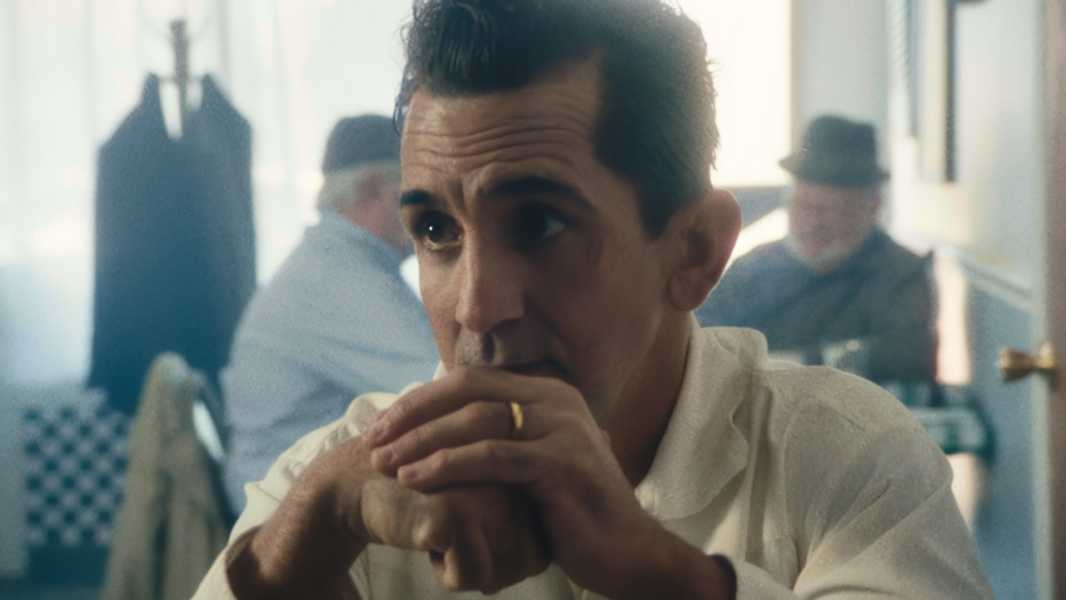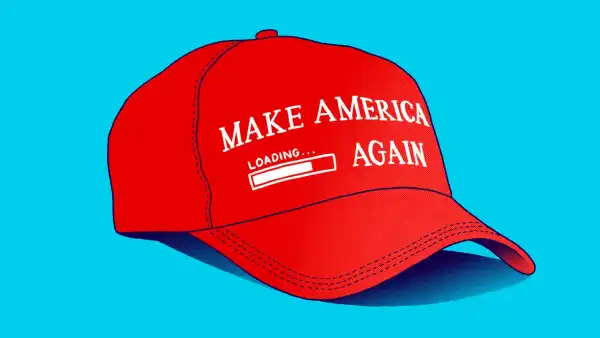
Save this storySave this storySave this storySave this story
The prime exemplars of modern documentary, centered on filmmakers’ close involvement with their subjects, are fundamentally transactional. They depend on the willingness of participants to let the filmmakers follow them in public and in private, and thus on what the participants think is in it for them to be filmed so intimately. The spate of documentaries that put nonfiction films on the artistic map in the nineteen-sixties (such as “Primary,” “Salesman,” and “Don’t Look Back”) are all essentially works of coöperation, even collaboration, but also of willing subjection to the filmmakers’ authority and authorship. Those films—the styles that they set, the methods that they advance, the conflicts that they imply—involve trust, which is the prime fault line of conflict in Robert Kolodny’s first feature, “The Featherweight,” a faux documentary with nothing “mock” about it.
Kolodny, working with a script by Steve Loff, tells the story of the real-life former champion boxer Willie Pep’s effort, starting in 1964, to make a comeback at the age of forty-two. That comeback is both the subject of the film and its premise: as part of his effort, Willie (James Madio) has recruited a pair of documentarians to follow him around, in order to create a portrait of him that he can use for self-promotion. “The Featherweight” purports to be the resulting film. Kolodny’s feature doesn’t merely depict the era but masquerades as a product of the era, deftly and poignantly emulating the style of a mid-sixties documentary. The fictional filmmakers, the director Herman Zupan and the cameraman Murray Zupan, are never seen, but their voices (uncredited) are heard. Their partnership appears to be a sly nod both to the Maysles brothers (who came to prominence with “Salesman”) and to Kolodny’s collaboration with his own brother Adam, the film’s cinematographer.
“The Featherweight” plays it straight throughout; there are no winks to suggest distance, irony, or fabrication. Rather, it plays as an eerie time capsule, reproducing its chosen setting with an uncanny eye not just for material details but also for the ethos that underpins them, as embodied in the characters’ styles of self-presentation. The dramatic manner of the simulated documentary, the way its cinematic forms spotlight characters’ affects, is similarly uncanny, as if recovered by time machine from the period in question. The story is set mainly in Willie’s home town of Hartford, Connecticut, where he’s a local hero, but one whose star is dimming. Willie is slight (the weight limit for featherweights is a hundred and twenty-six pounds), springy on his feet, and fast-talking, as if smacking the air in sharply focussed verbal jabs.
Willie was born Guglielmo Papaleo, the son of Sicilian immigrants, in 1922; his professional career ran from 1940 to 1959, and his postretirement plan to return to the ring has both practical and personal motives. Willie, on his fourth marriage, needs the money. His only other source of income is from the nostalgia circuit: he attends banquets with a retired opponent, Sandy Saddler (Lawrence Gilliard, Jr.), serving basically as Saddler’s self-deprecating comedic opening act; he sits grimly at poorly attended fairs waiting to sign photos for fans who never show up. He refuses to sell his one valuable possession, the gloves he wore when he first won the championship, and is resentful of his astute and active manager, Bob Kaplan (Ron Livingston), for suggesting that he get a regular job.
Willie is too proud to get a regular job; he’s used to stardom and, although he has been beaten, he has never been humbled. He’s unwilling to do anything like working his way up, anything that suggests he’s anything but a star from Day One. His preening, bombastic manner only gets him so far. His longtime trainer, Bill Gore (Stephen Lang), now runs a boxing gym; Bill’s gruff and witty candor pointedly aims to puncture Willie’s fantasy of a comeback. Bill Lee (Michael Siberry), a local sports journalist and a self-confessed fan of Willie’s, knows that the fighter is done but can’t say so—except to the camera.
Meanwhile, the façade of Willie’s family life is falling apart, too. He’s married to a considerably younger woman named Linda (Ruby Wolf). Nineteen when they first met and almost twenty-one when they married, she is now (in 1964) seemingly in her early twenties and immensely frustrated. An aspiring actress, she planned to live in New York, but Willie brought her back to Hartford to live—largely under the critical gaze of her mother-in-law (Imma Aiello), who thinks that he’d be better off with a Sicilian wife. Willie schleps Linda around on the banquet circuit, which she observes skeptically with a keen view of its tawdriness. When she has a bit of success re-starting her career locally, he reacts with jealous rage, and she, too, has no one around to confide in except the documentarians.
Throughout, the Zupans are present to capture moments in the lives of the Papaleo family that are unlikely to burnish Willie’s reputation. He’s a lively and sympathetic onscreen presence, joking with men at a social club, play-fighting with the camera, exhibiting the disciplined exertions of his training routine, visiting his ailing father in the hospital—but his self-delusions and his vanity come quickly and painfully to the fore, as do the spoiled relationships that his self-centered nature has left in its wake. (So does the primordial pain that drove him to become a fighter.) Willie’s son Billy (Keir Gilchrist), seemingly around twenty, is deeply bitter over his parents’ divorce and his resulting separation from his mother, and he’s aggressively hostile toward Linda; he’s also a drug addict and his habit becomes a problem for Willie, too. (Billy is also an expert at acting-out, grabbing the filmmakers’ boom mike to demand a cigarette.) Willie worries that the Zupans are an annoyance to his mother, but she mollifies him, calling them (in Italian), “good boys.” The filmmakers and the participants play along with one another—Willie addresses them jovially, Linda even does the slate for several shots—but when Linda implores them not to include a sequence or Willie tells them to stop filming, they brook no interference and do things their own way.
Kolodny has rounded up an extraordinarily committed cast of actors, whose mannerisms and inflections are sharpened and roughened, tuned and inflected to feel like archeological rediscoveries of behaviors past. Madio’s deeply inhabited portrayal of Willie comes off less like an impersonation than an incarnation, and Wolf nearly takes over the movie with the force of Linda’s pressurized desires. The acting is matched by the work of the production designer Sonia Foltarz, the costume designer Naomi Wolff Lachter, and the hair and makeup team; these material inspirations are as crucial to the movie’s emotional world as are the performances and the cinematography. Kolodny’s direction is exquisitely alert to the power of objects, as with a seemingly casual yet joltingly timed glimpse of an ill-gotten fur coat. “The Featherweight” recreates a time and a place in which public and private lives—long kept separate by the self-censorship of social mores and the actual censorship of production codes—were beginning to converge, and when myths of celebrity virtue and athletic valor were eroding. It was also a time when self-expression was becoming a prime value, albeit one to which introspection and ethics were slow to catch up.
Cinema vérité, the movement to which the Zupans’ work belongs, was a participatory mode of filmmaking, effacing the distinction of the observer and the observed and ostensibly bringing filmmakers and subjects together in a unified field of action. “The Featherweight” puts the moral implications of that implied yet inescapable complicity under intense scrutiny. It’s a scrutiny that Kolodny is well-placed to provide: he previously worked with Laura Poitras on her portrait of Nan Goldin, “All the Beauty and the Bloodshed,” and he has long worked with Robert Greene, a documentarian whose films (such as “Procession” and “Kate Plays Christine”) are devoted to examinations of process. (Greene edited and co-produced “The Featherweight.”)
Kolodny’s film is a touching, disquieting, relentlessly fascinating view of a troubled soul and of the world of trouble he belongs to. It’s an instant classic of a boxing movie, with its closeup view of the inseparable agonies and passions of a sport that’s shadowed with death. It’s an absorbing journalistic glance behind the scenes at a once-famed historical figure. But, above all, it’s a work of critical cinematic history, of self-criticism regarding the practice of nonfiction film—and, as such, it’s a vital reflection on the present day. ♦
Sourse: newyorker.com






